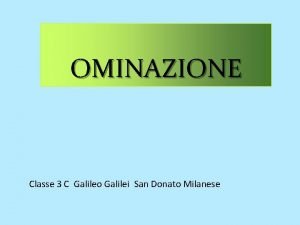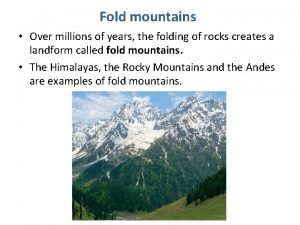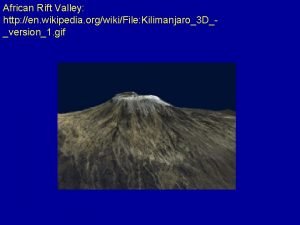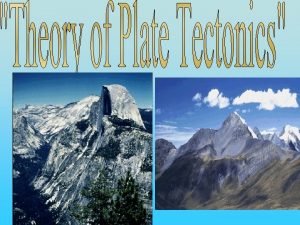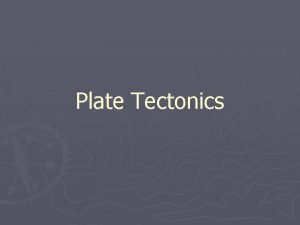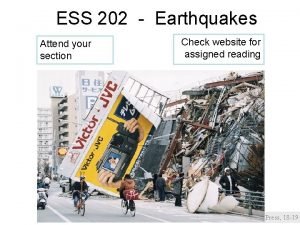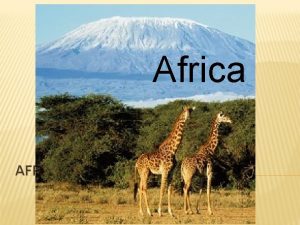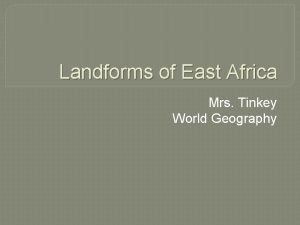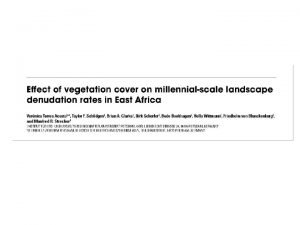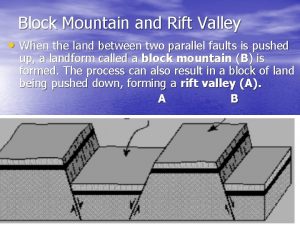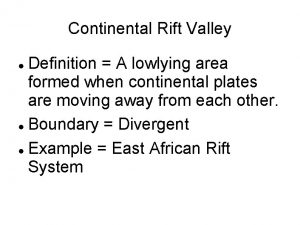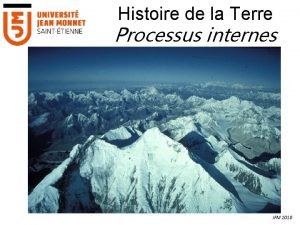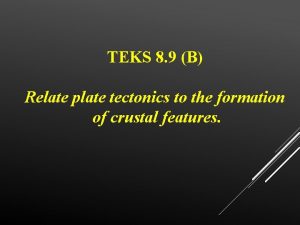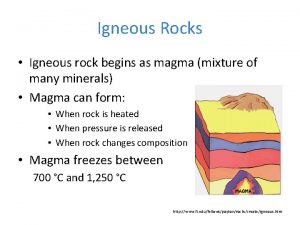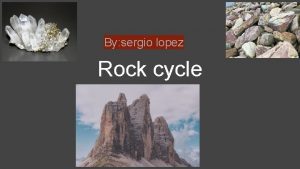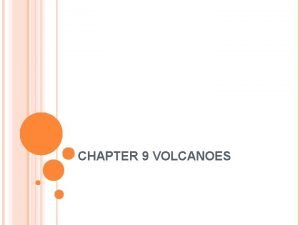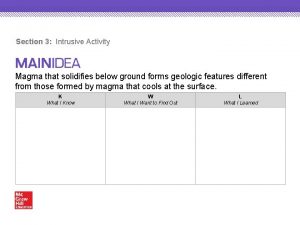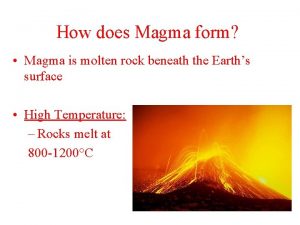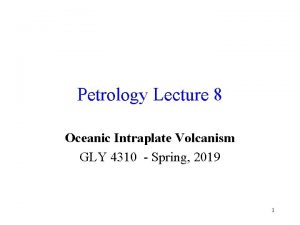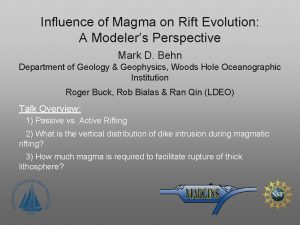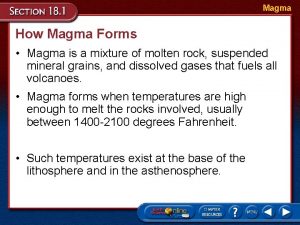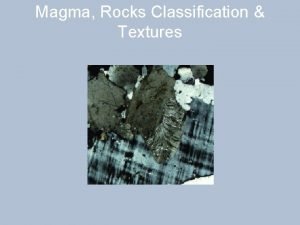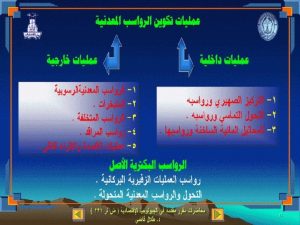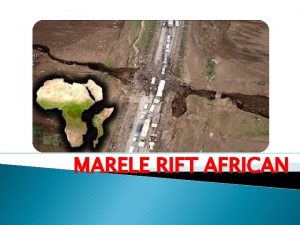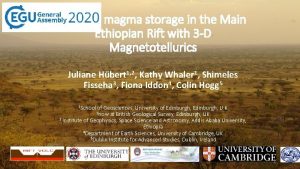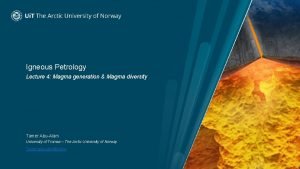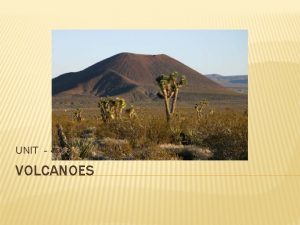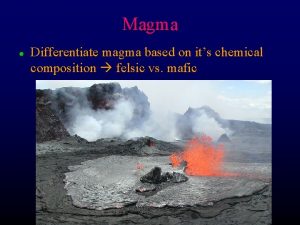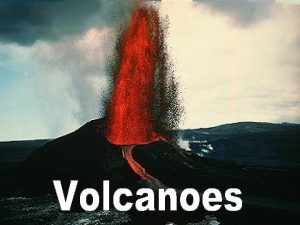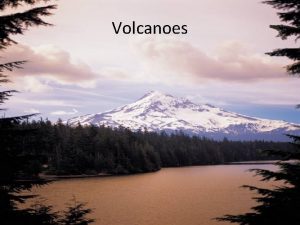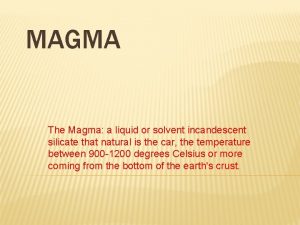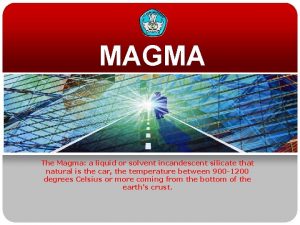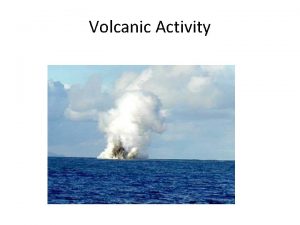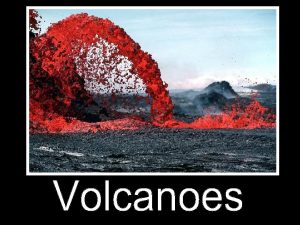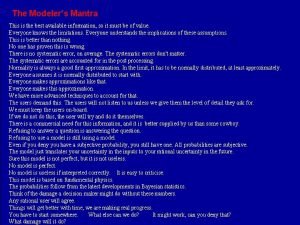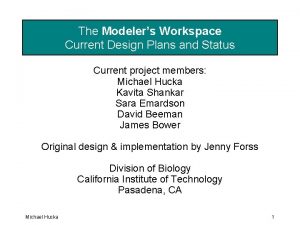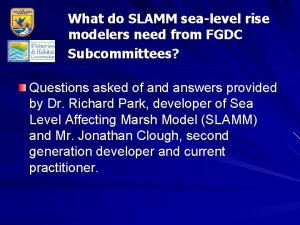Influence of Magma on Rift Evolution A Modelers

























- Slides: 25

Influence of Magma on Rift Evolution: A Modeler’s Perspective Mark D. Behn Department of Geology & Geophysics, Woods Hole Oceanographic Institution Roger Buck, Rob Bialas & Ran Qin (LDEO) Talk Overview: 1) Passive vs. Active Rifting 2) What is the vertical distribution of dike intrusion during magmatic rifting? 3) How much magma is required to facilitate rupture of thick lithosphere?

Magmatism at Continental Rift Zones White & Mc. Kenzie (1989) Many continental rift zones are accompanied by massive igneous activity often in the form of flood basalt provinces.

Seismic Evidence for Magmatism at Continental Margins EDGE Mid-Atlantic Seismic Profile (Holbrook et al. , 1994) Guaymas Go. C Seismic Profile (Lizarralde et al. , 2007) Thick sections of high velocity igneous crust and/or seaward dipping reflector sequences are observed at many continental margins.

Passive vs. Active Rifting White & Mc. Kenzie (1989) Huismans et al. (1991) Leitch et al. (1998)

Passive vs. Active Rifting Huismans et al. (1991) Magmatism associated with passive rifting occurs in response to extension and thus major magmatism should post-date the initiation of rifting. Magmatism associated with active rifting is generated by excess mantle upwelling from a plume or other mantle anomaly. In this scenario magmatism may pre-date continental breakup.

Timing of Igneous Activity Relative to Rift Initiation Courtillot et al. (1999) In many settings major igneous activity precedes or coincides with the initiation of rifting, suggesting that magmatism is associated with active rather than passive upwelling.

Regional 20– 24 Ma Diking Event in the Red Sea It is possible that lithospheric weakening associated with the regional diking event in the Red Sea at 20– 24 Ma may have facilitated rupture in this region.

“Tectonic Force” Paradox in Amagmatic Rifting Models Buck (2007) Force available for rifting is typically on the order of 3– 5 tera. Nt/m (Forsyth & Uyeda, 1975; Solomon et al. , 1980; Buck, 2004). However, the force required to rift normal to thick continental lithosphere is often significantly larger than this available tectonic force.

Can Magmatism Explain this “Tectonic Force” Paradox? Buck (2007) Magmatic rifting requires significantly less tectonic force than does amagmatic rifting. Thus, early magmatism associated with active rifting provides a plausible solution to the “tectonic force” paradox. But how is this magma distributed with depth and how much magma is required for rupture?

Can Magmatism Explain this “Tectonic Force” Paradox? Buck (2007) Goals of this Talk: 1. What is the vertical distribution of magma intrusion in the crust during rifting. 2. How much magma is required to facilitate rupture of thick continental lithosphere.

What is the Vertical Distribution of Dikes Through the Crust? Behn et al. (2006) The intrusion of “blade-like dikes” could result in a larger proportion of magma injected at depth than near the surface. Is this representative of the time-averaged distribution of magma in the lithosphere?

2005 Afar Dike Intrusion Event Wright et al. (2006) The 2005 Afar diking event was characterized by greater opening at depth than at the surface and subsidence on normal faults.

Model Setup for Intrusion of Blade-Like Dikes • Magma intrusion is simulated by widening a column of elements in the lower part of the lithosphere. • Goal: How does a rift system evolve in response to continual injection of blade-like dikes?

Topographic Controls on the Vertical Distribution of Magma Behn et al. (2006) Continuous injection of blade-like dikes generates normal faults and produces large rift topography. If this topography becomes too extreme it will create compressional stresses at the base of the plate (even in the presence of regional tensile stresses), inhibiting further dike intrusion at depth.

Topographic Stresses lead to Redistribution of Magma in the Crust Behn et al. (2006)

Better Methods for Calculating Dike Intrusion in Long-Term Models of Rift Evolution Figure from Ran Qin & Roger Buck By using the stress field at each time-step dike opening can be calculated as a function of the available volume of magma using numerically efficient boundary element methods.

Vertical Distribution of Dike Intrusion During Rifting Low Magma Flux High Magma Flux Bialas et al. (in prep) While individual blade-like dikes may occur, over the long-term evolution of a magmatic rift, the vertical distribution of dike intrusion is likely to be relatively uniform.

Model Setup to Quantify the Role of Magma on Rift Evolution • Numerical models incorporate both thermal and mechanical effects of dike intrusion after Behn & Ito (2008). • Magma is injected only at times when the applied tectonic force exceeds the available force • Goal: Determine the minimum volume of magma required to initiate rifting as a function of crustal and lithospheric thickness, and the available tectonic force. Note: This approach is not meant to simulate the true temporal evolution of magmatism at a rift — only to estimate the minimum volume of magma required for

Model Stage 1: Initial Amagmatic Extension (Initial Lithospheric Thickness = 40 km, Uo = 2 cm/yr) 600ºC During early rifting the applied force remains below the available tectonic force and extension is amagmatic with shallow, distributed faulting in the lithosphere.

Model Stage 2: Magmatic Extension (Initial Lithospheric Thickness = 40 km, Uo = 2 cm/yr) 600ºC When the applied force exceeds the available tectonic force, magma is injected and extension is accommodated by dike intrusion. During this period the heat associated with dike intrusion thins and weakens the lithosphere.

Model Stage 3: Final Amagmatic Extension (Initial Lithospheric Thickness = 40 km, Uo = 2 cm/yr) 600ºC After a sufficient volume of magma has been intruded into the lithosphere, it becomes weak enough for extension to continue at force levels below the available tectonic force. At this point no additional magmatism is required and the total volume of magma required for rift initiation can be estimated.

Volume of Magma Required for Lithospheric Rupture Volume of magma required for rifting increases approximately linearly with initial lithospheric thickness and exponentially with decreasing available tectonic force. Extrapolating to a ~1000 -km rift we predict volumes of magma that are approximately an order of magnitude less than is observed in many large igneous provinces.

Regional 20– 24 Ma Diking Event in the Red Sea It is possible that lithospheric weakening associated with the regional diking event in the Red Sea at 20– 24 Ma may have facilitated rupture in this region.

Conclusions 1. Feedbacks between dike intrusion, faulting, and topography result in a relatively uniform time-averaged distribution of magma in the crust during rifting. 3. Relatively small amounts of magma early in rift evolution can facilitate the rupture of thick, cold lithosphere. This model requires initial magmatism to be associated with active rather than passive rifting. 3. This is consistent with observations from many continental rifts where major igneous activity precedes lithospheric rupture. Future Directions 1. Models that incorporate melting and melt migration with thermal evolution of the rift. How does subsidence history fit into this picture of active rifting? 2. Better understanding of the 3 -D distribution of dike intrusion throughout the lithosphere. 3. How does extrusion affect rift evolution?

Models of Extrusion Immediately after Emplacement ~3 Myr after Emplacement Courtesy of Rob Bialas
 Cespuglio evolutivo dell'uomo scuola primaria
Cespuglio evolutivo dell'uomo scuola primaria Images of block mountain
Images of block mountain Great african rift valley
Great african rift valley Earth history
Earth history Rift valley
Rift valley Myo
Myo Advantages of plain sawing
Advantages of plain sawing Mid ocean rift valley
Mid ocean rift valley Great rift valley interesting facts
Great rift valley interesting facts Michael heizer rift
Michael heizer rift Great rift valley on map
Great rift valley on map Whats a rift valley
Whats a rift valley Block mountain rift valley
Block mountain rift valley Africa landforms map
Africa landforms map Jeff tantsura
Jeff tantsura Great rift valley definition
Great rift valley definition Le rift
Le rift Rift valley plate boundary
Rift valley plate boundary Plate tectonics test review answer key
Plate tectonics test review answer key Magma
Magma Magma facts
Magma facts How is magma formed
How is magma formed Magma
Magma Magma
Magma Oni magma volcano tamer
Oni magma volcano tamer Magma
Magma
